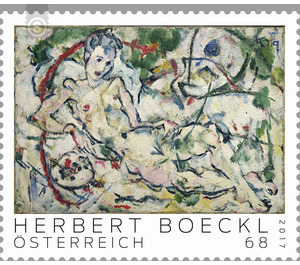Modern Art - Austria / II. Republic of Austria 2017 - 68 Euro Cent
Theme: Art & Culture
| Country | Austria / II. Republic of Austria |
| Issue Date | 2017 |
| Face Value | 68.00 |
| Edition Issued | 180,000 |
| Printing Type | offset |
| Stamp Type | Commemorative |
| Item Type | Stamp |
| Chronological Issue Number | 2684 |
| Chronological Chapter | OOS-OE2 |
| SID | 645554 |
| Dimensions | 35.00 x 42.00 |
| In 71 Wishlists | |
Herbert Boeckl was born on 3 June 1894 in Klagenfurt and was interested in painting at an early age. He is considered one of the most important representatives of Austrian modernism. When he was not admitted to the Academy of Fine Arts in Vienna at the age of 18, he began to study architecture but did not give up painting. He met Adolf Loos and made contacts with other artists such as Egon Schiele, Carl Moll and Oskar Kokoschka. After the end of the First World War, he gave up his studies and opened an artist's studio in Klagenfurt. In 1919 he married Maria Plahna; she was model for many of his acts, including the "Lying Female Nude." Boeckl was artistically ahead of his time. His early works were characterized by a powerful expressionist style. Color was one of his most important means of expression. He used a few but strong colors, which were applied thickly and thus look almost plastic. His style changed in the course of his work several times and showed in his late stages and his involvement with the international abstract painting. In addition to oil paintings, he also made numerous drawings and watercolors. His favorite themes at the beginning were mainly portraits and nudes, later also still lifes, landscapes and anatomical studies. He died on January 20, 1966 and is buried in a grave of honor at the Vienna Central Cemetery. He has received numerous awards such as the Great Austrian State Prize, the Guggenheim Prize, the Austrian Decoration of Honor for Science and Art, and the Honorary Ring of the City of Vienna. Herbert Boeckl's oil painting "Liegender Frauenakt (White Act)" from 1919 is considered one of his major works and can be seen in the Leopold Museum in Vienna. The picture shows the figure of a woman in a black outline, a separation between her and the background space is barely recognizable. After the death of Gustav Klimt, Egon Schiele, Otto Wagner and Koloman Moser in 1918, Herbert Boeckl was regarded as the main representative of modernism in Austria and decisively shaped the local art of the 20th century.


